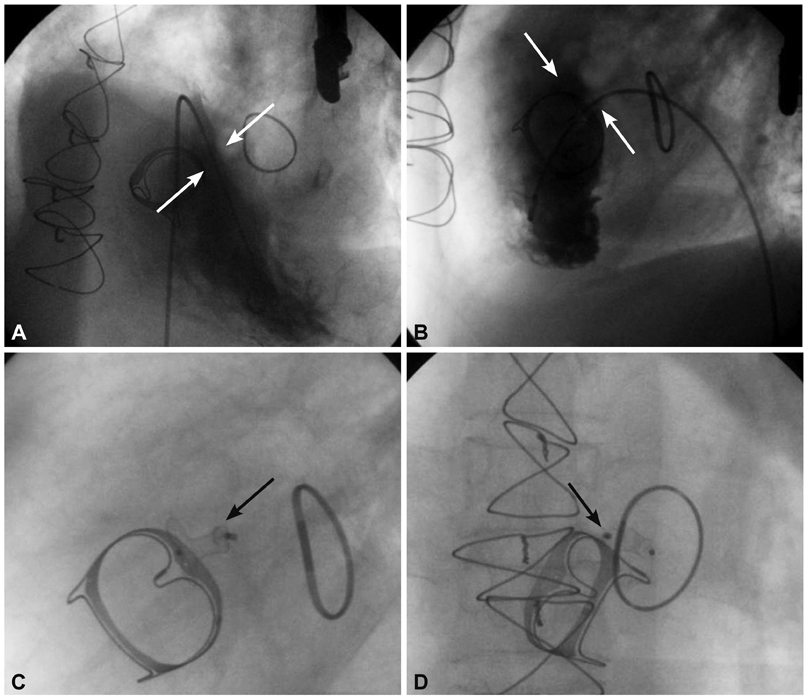Korean Circ J.
2013 Apr;43(4):273-276. 10.4070/kcj.2013.43.4.273.
A Case Demonstrating a Percutaneous Closure Using the Amplatzer Duct Occluder for Paravalvular Leakage after Tricuspid Valve Replacement
- Affiliations
-
- 1Department of Pediatrics, School of Medicine, Kyung Hee University, Seoul, Korea.
- 2Division of Pediatric Cardiology, Department of Pediatrics, Konkuk University School of Medicine, Seoul, Korea. ksoojn@yahoo.co.kr
- 3Department of Pediatrics, Sejong General Hospital, Bucheon, Korea.
- KMID: 2224952
- DOI: http://doi.org/10.4070/kcj.2013.43.4.273
Abstract
- There has been a dramatic increase in the number and type of procedures performed in the field of cardiac intervention in the past decade. Percutaneous intervention is becoming an increasingly recognized modality for the management of prosthetic paravalvular leakages (PVLs) in severely symptomatic non-surgical candidates. Herein, we report our experience of percutaneous closure using the Amplatzer duct occluder for a PVL in a patient who underwent tricuspid valve replacement.
MeSH Terms
Figure
Reference
-
1. King TD, Thompson SL, Steiner C, Mills NL. Secundum atrial septal defect. Nonoperative closure during cardiac catheterization. JAMA. 1976. 235:2506–2509.2. Rashkind WJ, Mullins CE, Hellenbrand WE, Tait MA. Nonsurgical closure of patent ductus arteriosus: clinical application of the Rashkind PDA Occluder System. Circulation. 1987. 75:583–592.3. Piéchaud JF. Percutaneous closure of mitral paravalvular leak. J Interv Cardiol. 2003. 16:153–155.4. Moscucci M, Deeb GM, Bach D, Eagle KA, Williams DM. Coil embolization of a periprosthetic mitral valve leak associated with severe hemolytic anemia. Circulation. 2001. 104:E85–E86.5. Hein R, Wunderlich N, Robertson G, Wilson N, Sievert H. Catheter closure of paravalvular leak. EuroIntervention. 2006. 2:318–325.6. Orszulak TA, Schaff HV, Danielson GK, Pluth JR, Puga FJ, Piehler JM. Results of reoperation for periprosthetic leakage. Ann Thorac Surg. 1983. 35:584–589.7. Dávila-Román VG, Waggoner AD, Kennard ED, et al. Prevalence and severity of paravalvular regurgitation in the Artificial Valve Endocarditis Reduction Trial (AVERT) echocardiography study. J Am Coll Cardiol. 2004. 44:1467–1472.8. Sorajja P, Cabalka AK, Hagler DJ, et al. Successful percutaneous repair of perivalvular prosthetic regurgitation. Catheter Cardiovasc Interv. 2007. 70:815–823.9. Rallidis LS, Moyssakis IE, Ikonomidis I, Nihoyannopoulos P. Natural history of early aortic paraprosthetic regurgitation: a five-year follow-up. Am Heart J. 1999. 138(2 Pt 1):351–357.10. Dhasmana JP, Blackstone EH, Kirklin JW, Kouchoukos NT. Factors associated with periprosthetic leakage following primary mitral valve replacement: with special consideration of the suture technique. Ann Thorac Surg. 1983. 35:170–178.11. Bhindi R, Bull S, Schrale RG, Wilson N, Ormerod OJ. Surgery Insight: percutaneous treatment of prosthetic paravalvular leaks. Nat Clin Pract Cardiovasc Med. 2008. 5:140–147.12. Lasorda DM, Mohsin JC. Percutaneous closure of perivalvular mitral regurgitation with an Amplatzer occluder device in a patient with both prosthetic mitral and aortic valves. J Interv Cardiol. 2008. 21:190–195.13. Echevarria JR, Bernal JM, Rabasa JM, Morales D, Revilla Y, Revuelta JM. Reoperation for bioprosthetic valve dysfunction. A decade of clinical experience. Eur J Cardiothorac Surg. 1991. 5:523–526. discussion 527.14. Hourihan M, Perry SB, Mandell VS, et al. Transcatheter umbrella closure of valvular and paravalvular leaks. J Am Coll Cardiol. 1992. 20:1371–1377.15. Pate GE, Thompson CR, Munt BI, Webb JG. Techniques for percutaneous closure of prosthetic paravalvular leaks. Catheter Cardiovasc Interv. 2006. 67:158–166.16. Kort HW, Sharkey AM, Balzer DT. Novel use of the Amplatzer duct occluder to close perivalvar leak involving a prosthetic mitral valve. Catheter Cardiovasc Interv. 2004. 61:548–551.17. Fanning JP, Cox SV, Scalia GM. Percutaneous closure of an aortic prosthetic paravalvar leak: an Australian first. Heart Lung Circ. 2012. 21:174–177.
- Full Text Links
- Actions
-
Cited
- CITED
-
- Close
- Share
- Similar articles
-
- Percutaneous Forceps Retrieval of an Embolized Amplatzer Duct Occluder
- Management of Recurrent Paravalvular Leakage in a Very High-Risk Patient: A Case Report
- Percutaneous Closure of the Acquired Gerbode Shunt Using the Amplatzer Duct Occluder in a 3-Month Old Patient
- Percutaneous Transcatheter Closure of Congenital Ventricular Septal Defects
- Comparable Outcomes of Bicuspid Aortic Valves for RapidDeployment Aortic Valve Replacement



